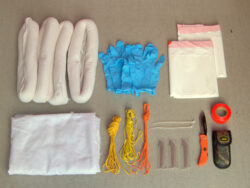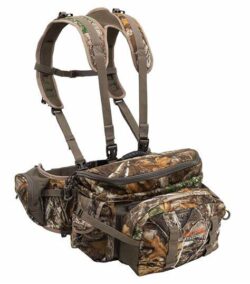I always wondered why gutting a critter is called “Dressing”. It does sound better “gutting” but you certainly do not put clothes or a salad onto a downed deer or elk. No matter what you call it, dressing a tagged critter is a responsibility that can be a bit messy.
Once you pull the trigger or release, and the critter is down it is time to begin the real work. Before you unpack the knives, saws, and gloves, get out and fill out your legal Big Game tags. Attach these tags immediately to the critter.
There are several ways to attach a tag. If you are transporting the entire critter, safety pin the completed tag in the ear. This will protect the tag from getting pulled off during transport. You can also use tape to attach the tag to the antler or horn. In Montana, proof of sex is required if the animal is being quartered and transported. This means that the male and female organs need to be attached to the rear quarter. Thid is also where you need to attach the completed tag. Remember that your hunting license needs to be with you in the field or on your cell phone photo library.
As you can see, I am already being positive about your successful hunt. The next thing to prepare for is your processing or Gut Gear! You need to carry several items to make gutting or dressing your critter safe and complete. Here are some items to carry in your pack.
Sharp knives/ sharpener Having a couple knives is a good idea. You may carry one on your belt, but a second sharp blade may be needed for an especially big critter. Big Game hair will dull an edge quickly. Cutting against bone is also a dulling event. A fast touch up of a blade will speed up the game processing.
Meat saw Cutting the spine and lower legs is easily done with a saw. Using a knife can result in a broken blade, injury, or dulling of the knife. A Wyoming saw has both a bone and a wood blade. If you need to hang the meat, cutting branches may be required. You may also need to clear a trail for transport of the critter.
Axe If you lack a saw or big knife, an axe will work well for quartering. It’s a bit messier but will do the job. A short, handled axe will do the job. Some saws, like the Gerber brand, come with a saw inside the handle.
Rubber gloves Health is a concern when processing your critter. Guts contain cooties that can make you sick. Wear gloves for the entire process. Have extra gloves in case they tear. You can also wear 2 pair at the same time. I use shoulder length gutting gloves with a surgical rubber glove over the hands. This keeps your clothes from getting bloody. Get large sized gloves.
Meat bags If you are going to quarter your critter, cloth game bags are a must. Different sized critters require a different number of bags. Moose, 8 bags, elk, 7 bags, deer 4 bags, antelope 3 bags. The head or antlers can be carried separately. These washable bags are large, airy, and protect meat from dirt and insects.
Parachute cord If you plan to transport the meat after quartering a critter, you may need to shuttle the meat bags. I have never tagged an elk closer than 3 miles from a camp or road. This means packing out the 100 lb. sacks. Heavier sacks can be dangerous to haul. Get the meat sacks away from the carcass asap. Predators will be drawn to the gut pile before they go after your meat. If you need to leave the meat overnight, suspend the sacks from a tall tree. It needs to be at least 20 feet high. Hang the meat sacks in different trees a short distance apart.
Battery tools These tools are a luxury item but can save a lot of time. Lighter than a gas chain saw, a battery saw will allow you to quickly cut off legs, spine, and neck. Use vegetable oil for the chain oil. These saws can be carried by a horse or on a wheeler.
Hand sanitizer Clean your hands and blades using this lotion. You do not want any cross contamination. This is especially important when using a saw. Cerebral or spinal fluid can spread rabies and other diseases. Save these cuts for last and clean the blades/edges.
When to Quarter Solo hunters know when to quarter a critter. There is no way that you will drag an elk, moose, big deer, or large critter. Divide and conquer. This also leaves a lot of the mess afield and not in your truck. Just be certain to tag the meat with the proof of sex.
Watch for predators Grizzly bears can smell blood from over 20 miles away. Other critters like cougars, wolves, and other carnivores enjoy a free, fresh meal. Be alert! Have your weapon/ bear spray close and frequently scan for danger. Separate the critter from the guts asap. Noise is a good thing.
A pack designed to haul at least a quarter. Now is when you need a pack that can fit your gear and a rear leg quarter. Some packs fold open to a large size for this purpose. You will be more stable with a secure pack than carrying a sack of meat like Santa. Dragging meat sacks will quickly wear a hole in them. If you plan to drag the whole critter, place it on a thick tarp, remove the lower legs, and be ready for a workout.
Dress for Success!
Montana Grant